|
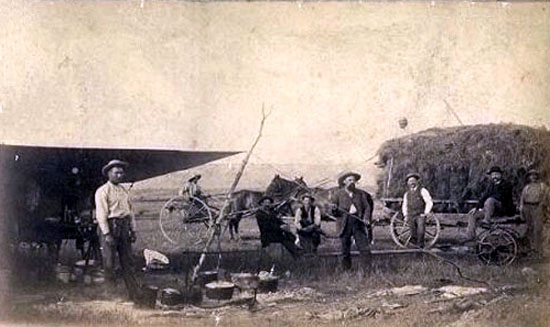
Hay Camp near Buffalo, Wyoming. Photo by Thomas Dalgleish, approx. 1890
With the advent of homesteading, irrigation and dry farming, the era of giant ranches relying on
open range came to an end. The ranchman's year was no longer marked by riding line in the winter,
spring roundup, fall roundup, but instead with a greater reliance upon alfalfa and winter feed and the planting of
other crops such as wheat, oats, and sugar beets, the year turned to the more to the more
prosaic planting, mowing, and stacking the hay for winter. There were, of course, the reminders of
the older ways. General roundups were gone. Instead, there was the small roundup for a single ranch such as
illustrated by Charles Belden on the Pitchfork. Short cattle drives to a railroad yard to ship the cattle off to Chicago remained. But the
life of the cowboy as it was in the imagination was gone. Indeed, the writer went out with his boys for a ride one day, and
the writer noted that the older of the two boys was not as skillful on his horse as one might hope. "I thought you helped out
on a ranch up in Chugwater." "Yes, Dad, but we rode around in pickup trucks," was the reply.
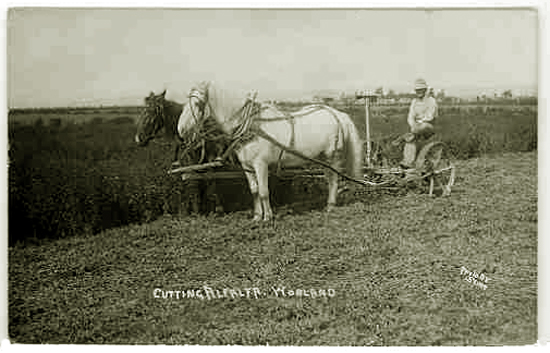
Cutting alfalfa, approx. 1909, near Worland.
At the haycamp, first the hay would be cut with a mowing machine drawn by a team of horses. The driver sat on a small metal seat mounted
on the frame. The seat was similar to that on olderJohn Deere or Farmall tractors. The wheels were connected to a sawtooth blade by gears
so that as the mower was pulled through the hayfield, the blade would move back and forth and cut a
swath about four or five feet wide. Because of the danger, only older boys, usually at least age 10, were permitted
to drive the mower.
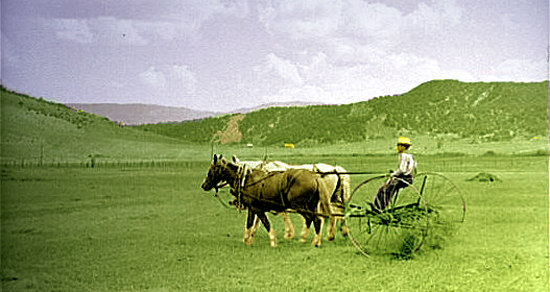
Hayrake, 1936
Following the mower, would be a hay rake pulled by one or two horses. The rake would pile the hay into piles about six feet long. By hand the
six-foot piles would be turned onto itself to created a shorter pile about 2 feet height. The hay was then left in
the field for several days to dry. When dry, the hay was placed with pitchforks onto a hayrack and then taken to
where the hay was to be stacked for the winter.
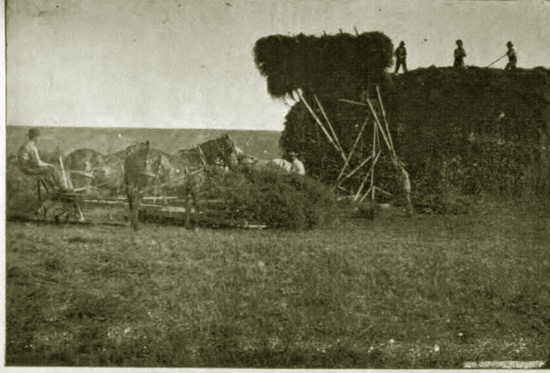
Stacking hay with a
Mormon haystacker or derrick, 1898.
Haystackers were usually homemade affairs and used a central pole rigged so that it could rotate on its
base. By means of pulleys and a single tree attached to a one-horse hookup, the loading fork could be raised. As it
was raised it would rotate over the haystack. When tripped, the hay would drop onto the stack. Men on top of the
stack would arrange the hay. The stack was so stacked that it would shed water so that the hay would cure rather
than rot.
The horse as then packed up, the fork pulled back with the tripping rope, and reloaded for the operation to
be continued. When the hay was released from the loading fork it might come down fairly rapidly and there was a danger of
getting caught up in the ropes. Additionally, another nasty surprise could occur. Occasionally rattlesnakes might be
hiding in the hay and provide a surprise for those on the grounds loading the fork or for those on
top of the hay pile when the fork was tripped.
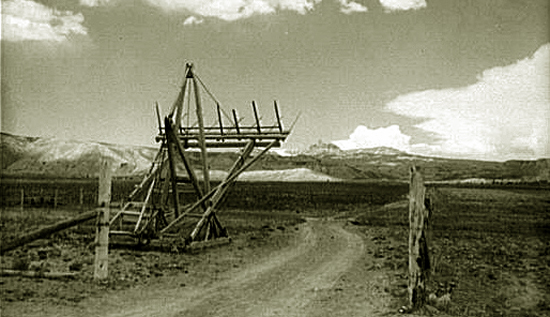
Mormon haystacker or derrick near Dubois, 1936.
By the beginning of World War II, hay would generally be bailed or put into long rolls and haystackers
fell into disuse. As indicated in the photos, horses remained in general use on farms until World War II.
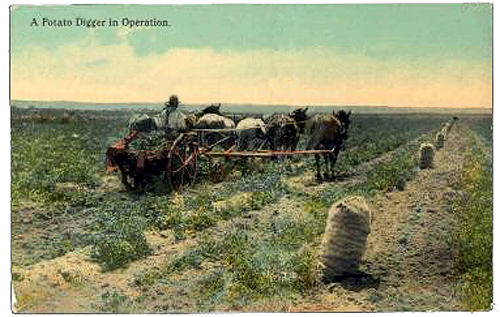
Potato digger, 1909. Photo by J. E. Stimson.
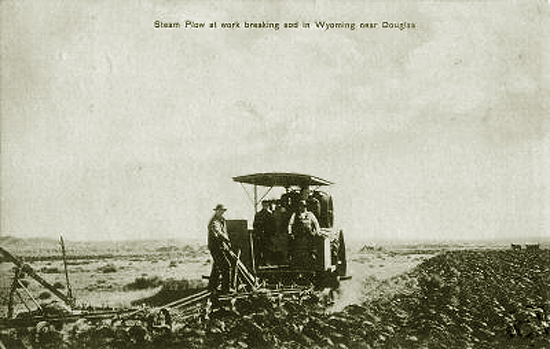
Steam Traction Engine pulling plow near Douglas, undated.
Although in the early years of the Twentieth Century steam
tractors or traction engines came into general use on the great plains for plowing, their use
was comparatively rare in most of Wyoming. In the Star Valley, as an example, in the 1920's there was
only one steam tractor which was available for thrashing on a contract basis. In areas where
sugar beets were grown and plowing on a large scale was necessary they were more common.
The Meeteetse Mercantile sold Case steam tractors. George W. Black in Basin also sold steam tractors.,p>

New Giant Steam Traction Engine near Worland, undated.
The New Giant Steam Traction engines were built by the Northwest Thresher Co. of Stillwater, Minn. The engine had a
20 or 25 hp. engine dependent upon the steam pressure. The tractors were equipped with a 40 inch flywheel and 100 gallon
water tank. The company was acquired by the Advance-Rumely Company in 1912. Wilth the Great Depression the
company fell on hard times and was acquired for its dealer network by
Allis-Chalmers in 1931. It was necessary to start firing up the engine about 3:30 in the morning in order start threshing by 6:00 a.m.
Steam traction engines could use a variety of fuel including wood, oil, and straw.
Horses for lighter equipment gave
way when light gasoline tractors such as Farmall and John Deere became available. Farmers would save money by
starting a tractor with gasoline and after the engine started switching to kerosene. The lighter tractors were
available in both a tricycle configuration; that is with a single front wheel or two front wheels
with a wider stance. The advantage of the
tricycle tractor was that it had a much sharper turning radius. Thus, with the tricyle
configuration one could harrow or mow to the very edge of a field. The narrow tractor was much more dangerous in that it
could be easily overturned, crushing the operator.
Next page Johnson County War.
|